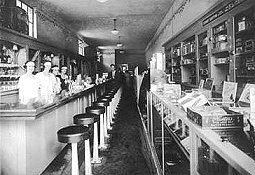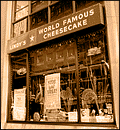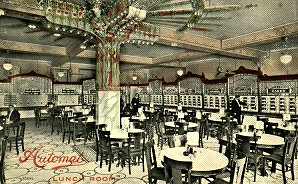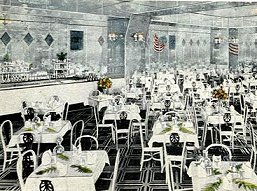|
more 1920s topics Nostalgia Cafe main page Nostalgia Cafe site map | Around Town in the 1920s============================================================ ============================================================ ============================================================ | ||
| this section is divided into 3 parts: | ----- | ----- | ||
 Shopping & Dining Restaurants, department stores and roadside establishments |  Travel & Nightlife Ballrooms, hotels, autocamping, speakeasies, highway amd train travel | |||
 Town & Country Views of city, small town and rural life | ||||
===========================================================================
===========================================================================
===========================================================================
===========================================================================
|
Dining Out Restaurant dining became incredibly popular in the 1920s. There were several reasons for this: our incomes were higher, our standard of living was higher, and there were more eateries to choose from than ever before. Plus, modern homemakers were beginning to assert themselves and demand occasional relief from cooking. Between 1919 and 1929, the number of restaurants in the United States increased by 300 percent. Of these, 48 percent were lunch rooms, 26 percent were coffee and sandwich shops, 8 percent were cafeterias, 11 percent were full-service eateries, and 7 percent fell into the category of "other," which probably included drive-ins, street vendors and snack stands. snack stands drive-ins street vendors White Castle (1921) Stewart's Root Beer (1924) A&W Root Beer Texas Pig Stand (1921) White Tower Triple XXX Root Beer Nathan's Famous Hot Dogs Orange Julius (1926) | ----- |
 The popularity of the automobile inspired the first drive-in restaurants. Both A&W (1919) and the Texas Pig Stand (1921) claim to be America's first drive-in. They had tray boys, curb girls and carhops to bring your food right to your car.  In 1926, Julius Freed opened a snack stand in Los Angeles that sold an improved blended orange drink. The establishment got its name when a customer shouted "give me an orange, Julius!" In 1926, Julius Freed opened a snack stand in Los Angeles that sold an improved blended orange drink. The establishment got its name when a customer shouted "give me an orange, Julius!"
| ||
  In 1925, Howard Deering Johnson opened a drugstore and soda fountain in Quincy, Massachusetts. In the basement, he perfected his ice cream recipe by increasing the butterfat content. He created 28 flavors, and soon he had customers lining up outside the door. He began selling his ice cream at area beaches, and in 1929 he opened a second location with an expanded menu that included sandwiches. The Howard Johnson chain was on its way! In 1925, Howard Deering Johnson opened a drugstore and soda fountain in Quincy, Massachusetts. In the basement, he perfected his ice cream recipe by increasing the butterfat content. He created 28 flavors, and soon he had customers lining up outside the door. He began selling his ice cream at area beaches, and in 1929 he opened a second location with an expanded menu that included sandwiches. The Howard Johnson chain was on its way! Before the 1920s, a standard milkshake consisted of milk, chocolate syrup and malted powder. In 1922, the soda fountain at Walgreens was the first to add ice cream to the combination. Walgreens Invents The Ice Cream Milkshake 
|
 ice cream parlors soda fountains sandwich shops 
Howard Johnson's (1925) Walgreens Soda Fountain Feltman's At Coney Island Barkies Sandwich Shops Pig 'n Whistle  In the 1920s, the number of office workers increased, while the length of a typical lunch break decreased. This created a need for eateries that could serve many lunches quickly. In response, drugstore soda fountains began to add food to their regular menu of sodas. In 1929, 60 percent of all drugstore sales took place at the fountain, and of those sales, 67 percent were of food, not sodas or ice cream. The Walgreens fountain could serve over 100 people per hour. 
| |||
|
cafes lunch rooms cafeterias Childs Automat Ariston Cafe (1924) Harvey House Lindy's (1921) Waldorf Lunch Thompson Lunchrooms * In 1889, the Childs restaurant chain pioneered the self-service cafeteria concept. In 1925, there were 107 locations in 33 cities, including a stunning new terra cotta building at Coney Island.  *In New York, Lindy's on Broadway immortalized the New York-style cheesecake. *Restaurant chains with standard menus and speedy service became popular, thanks to an increase in the number of office workers who needed quick lunches. Cafeterias (like Childs), mechanization (like the Automat) and cold lunches became acceptable for this reason. *In New England, the Waldorf Lunch chain had 112 locations in 1923. *In 1927, the Thompson Lunchroom chain had 113 locations in 45 cities. Small lunch rooms serving quick, light meals were often referred to as dairy lunches. |  At the Automat, diners put their nickels in the slots and opened glass doors to get their food. Automat History Meet Me At The Automat  When Route 66 was constructed in the 1920s, it was so heavily traveled that many of the motels and cafes along the way became nationally famous. The Ariston Cafe in Litchfield, Illinois was one of them.  Buck & Rayner Cafeteria, 1924 | |||
 * Over the years, there were seven Delmonico's locations in New York City. The last one opened in 1897 at Fifth Avenue and 44th Street. The restaurant was a symbol of the culinary excesses of the Gilded Age, and in the 1920s it couldn't compete with prohibition or America's changing eating habits. It closed for good in 1923. *In 1919, the Rose Room at the Hotel Algonquin became the site of a daily gathering of celebrities and intellectuals known as the Algonquin Round Table. Throughout the 1920s, the hot topics of the day were discussed by writers like Dorothy Parker, Robert Benchley, Robert E. Sherwood, George S. Kaufman, Edna Ferber and Alexander Woollcott. The group was often joined by celebrities like Harpo Marx, Tallulah Bankhead and Noel Coward. * In the Los Angeles area, the first Brown Derby restaurant opened on Wilshire Boulevard in 1926. There would eventually be four Brown Derby locations, but this was the only one shaped like a hat. A second location opened in Hollywood in 1929. The Algonquin Round Table American Masters: The Algonquin Round Table |
fine dining New York City Delmonico's Stock Exchange Luncheon Club Hotel Algonquin: -------Rose Room -------Oak Room Waldorf-Astoria: -------Empire Room Pierre Restaurant Sardi's Plaza Hotel: -------Tea Room Rector's The Colony Chicago Blackhawk Restaurant Marshall Fields: -------Walnut Room Colosimo's Edgewater Beach Hotel: -------Marine Dining Room Henrici's Palmer House The Berghoff Morrison Hotel: -------Terrace Garden Restaurant Los Angeles The Brown Derby (1926) | |||

continue to:
Dining Out (page 2)
or continue to:
Shopping
other pages in this section:
Travel & Nightlife
Town & Country
return to the 1920s main page